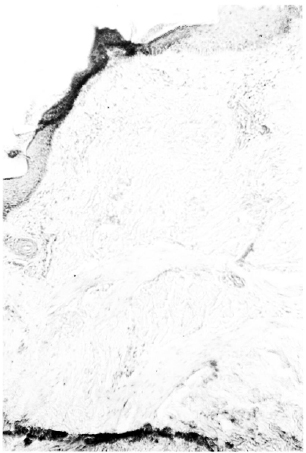- Volume 58 , Number 2
- Page: 382–4
Triethanolamine-lnduced allergic contact dermatitis over a tuberculoid leprosy lesion
To the Editor:
A 60-year-old man relapsed with a tuberculoid (TT) Hansen's lesion 30 years after treatment with low-dose dapsone for 4 years. Examination revealed a hypopig-mented, anhidrotic, anesthetic lesion 5 cm x 3 cm over the outer aspect of the left upper arm. He was treated with pulse doses of 600 mg of rifampin once a month and 100 mg of dapsone daily. Since he complained of dryness over the lesion, he was advised to use a topical moisturizing cream (Cotaryl®). Six months later he complained of itching over the hypopigmented lesion.
Examination revealed a mild erythema, scaling, oozing with lichenification over the TT lesion. A biopsy showed a tuberculoid granuloma in the upper dermis with spongiosis of the epidermis and mild edema of the dermis (The Figure). A provisional diagnosis of allergic contact dermatitis (ACD) to the moisturizer was made, and the ingredients of the moisturizer (Cotaryl®) were requested from the manufacturer. Patch tests were performed with the ingredients obtained from Chemotechnique Diagnostics AB. Sweden, using Vander Bend Chambers. Erythema and vesicles developed 48 hr following the application of 2% triethamol-amine (TEA) which is used to form the emulsifier system in the moisturizing cream. TEA is an emulsifier in skin-care products and cosmetics, such as moisturizers, foundation, lipstick, shampoos, etc.. (2) and has been reported to cause both allergic (1,2) and irritant dermatitis (1). A 2% concentration has been recommended to avoid irritant dermatitis (3). Only 0.5% TEA is used along with stearic acid to neutralize it completely and to form TEA stearate soap which acts as the chief emulsifying agent for the product, Cotaryl® cream (Dr. M. G. Wagh, Medical Adviser, FDC Limited, personal communication). Thus, there is no free TEA in the marketed cream (Dr. Wagh, personal communication).

The Figure. Photomicrograph showing mild spongiosis, dermal edema, diffuse mononuclear infíltrate in the upper dermis, and a tuberculoid granuloma (H&E x 10).
There is much debate over the role of melanocytes and melanin and functions other than protection from light are attributed to it (4,5). We have reported the sparing of vitiliginous skin in parthenium-induced ACD (5) and the sparing of nevus depig-mentosus in a case of textile dermatitis (4,8). We have also successfully induced re-pigmentation over a TT lesion following topical (6) and systemic PUVASOL (7); thus proving that melanocytes could be activated over a TT lesion. The role of abnormal Langerhans' cells and decreased melanocytes (4,5). diminished melanin (8), and the ability of the lesion to repigment following treatment (6,7) in the induction of allergic contact dermatitis needs further investigation. We conclude that although ACD over a TT lesion is unusual, it should be recognized since there is a risk of missing the diagnosis of leprosy in such a case.
- C. R. Srinivas, M.D.
Reader
Depart ment of Dermatology and S.T.D.
- Ambarish Padhee, M.D.
Assistant Professor
Department of Pathology
- N. D. George, M.B.B.S.
Resident
Department of Dermatology and S.T.D.
Kasturba Medical College and Hospital
Manipal 576119, India
Acknowledgment. We thank FDC Limited for providing us with the ingredients in Cotaryl®.
REFERENCES
1. Hannuksela. M., Kousa, M. and Pirilä, V. Contact sensitivity to emulsiliers. Contact Dermatitis 2(1976)201-204.
2. Jones, S. K. and Kennedy, C. T. Contact dermatitis from trielhanolamine in E45 cream. Contact Dermatitis 19(1988)230.
3. Maibach. H. i., Akerson. J. M., Marzulli, F. N., Wenninger. J., Greif, M., Hjorth, N., Andersen, K. E., and Wilkinson, D. S. Test concentrations and vehicles for dermatológical testing of cosmetic ingredients. Contact Dermatitis 6(1980)369-404.
4. Norlund, J. J., Forget, B., Kirkwood, J. and Levner, A. B. Dermatitis produced by applications of monobenzone in patients with active vitiligo. Arch. Dermatol. 121(1985)1141-1144.
5. Singh, K. K., Srinivas. C. R., Balaciiandran, C. and Menon, S. Parthenium dermatitis sparing vitiliginous skin. Contact Dermatitis 16(1987)174-178.
6. Srinivas, S. R. Photoaclivated topical S-methox-ypsoralen in repigmentation of a tuberculoid leprosy lesion. Int. J. Lepr. 56(1988)109-110.
7. Srinivas. C. R., Naik., R. P. C. Krupshankar, D. S. R. and MEnon, S. K. Photoactivated 8-methoxypsoralen in repigmentation of tuberculoid leprosy. Int. J. Lepr. 55(1987)159-160.
8. Srinivas, C. R., Singh, K. K. and BalacHandran, C. Textile dermatosis sparing nevoid depigmentation. Contact Dermatitis 16(1987)235.